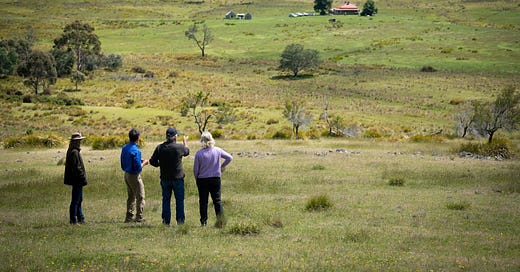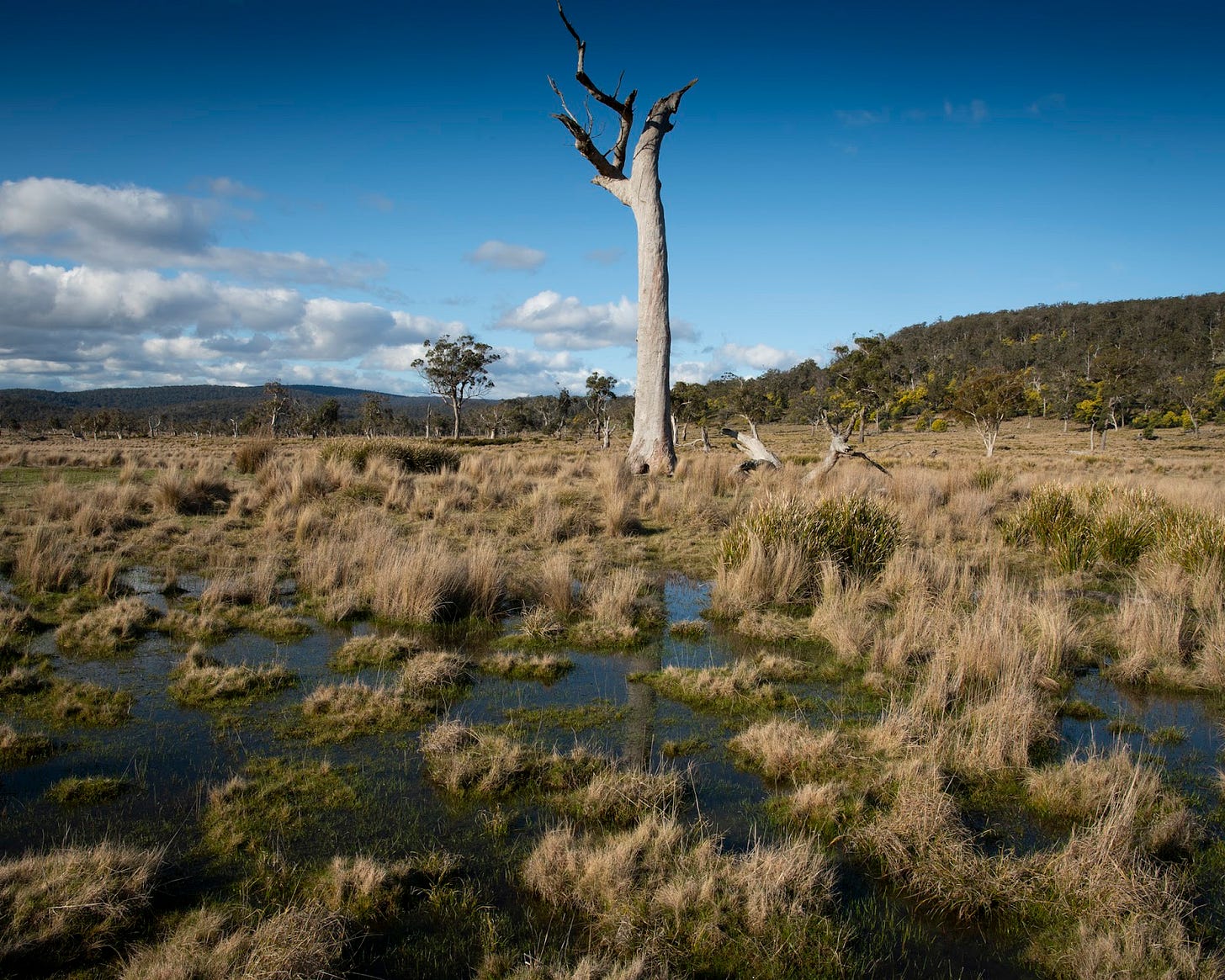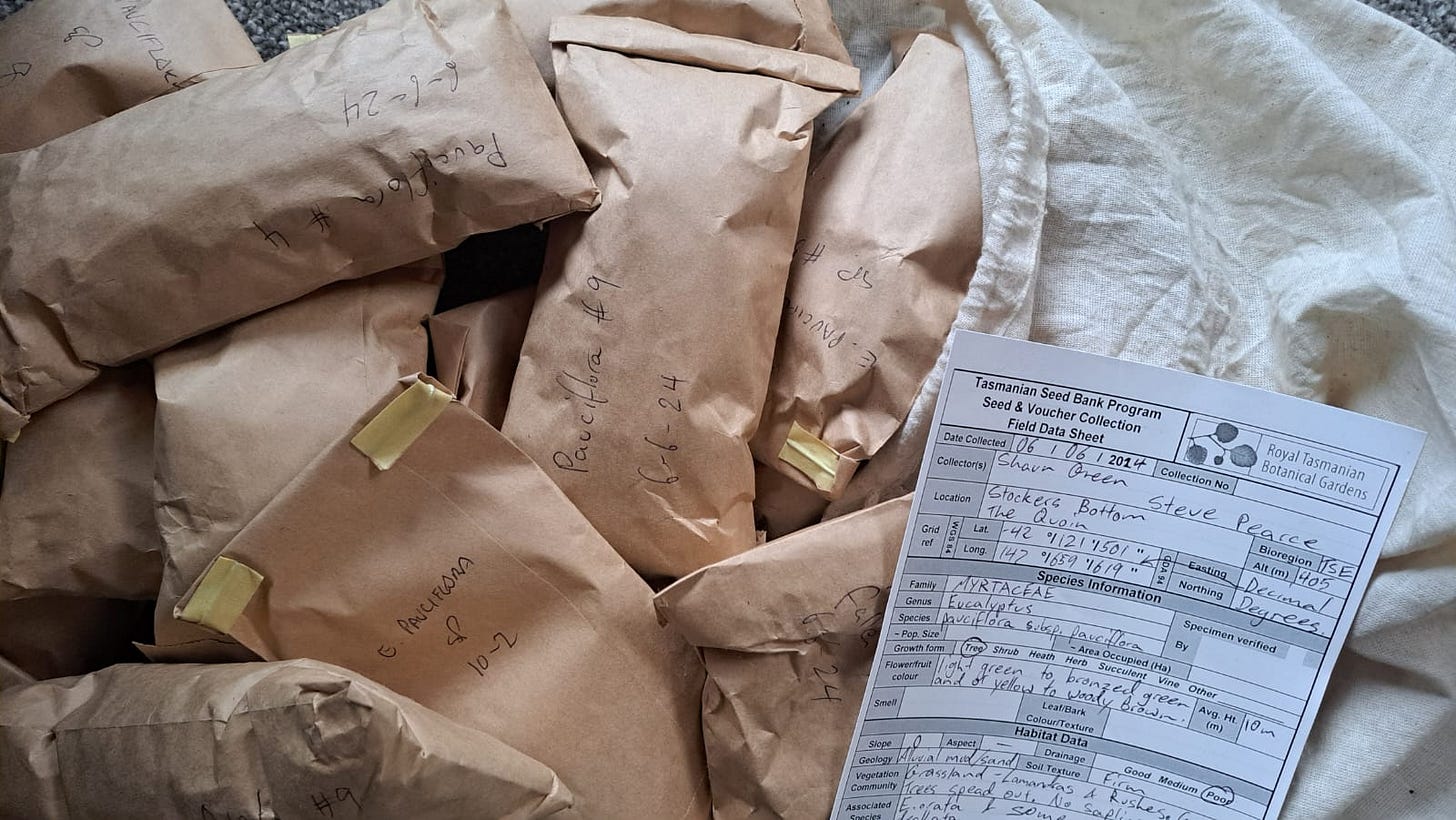Why we collected local seed for our first restoration project
In May, we collected 3.1kgs of material — about 78,000 seeds — from 20 eucalyptus trees at The Quoin.
Approximately 22% of The Quoin’s 5,000 hectares are in need of restoration.
These landscapes have undergone a ‘state change’ — before European settlement, they were most likely contiguous grassy woodlands, but in the 20th century, as agriculture intensified, trees were removed to modify the landscape and create space for sheep pasture. Today, these ecosystems are disproportionately composed of invasive perennial grasses. Our goal is to return them to functional, native ecosystems by encouraging the spread of native grasses and sedges and replanting trees in strategic locations.
But restoring an ecosystem isn’t simply a matter of picking up a shovel. In fact, it often involves far less shovelling than you might expect. In reality, ecosystem restoration is a multi-year, many-step process, in which how well you prepare and adapt early on determines your long-term success.
We began preparing by learning as much as we could about the property’s biodiversity, engaging Ecotec Environmental to survey the flora and fauna across The Quoin. From there, we created a Natural Capital Account, which gives us baseline data so we can measure the uplift in biodiversity over time. Our Natural Capital Account also helped us identify three sites in need of restoration: Honeysuckle Flat, Long and Big Paddocks and Stocker's Bottom.
We have opted to start with the 54 hectares we call Honeysuckle Flat because it’s most easily accessed and monitored, allowing us to test and learn on a smaller site before we move to larger, more complex sites.
Why restore an ecosystem at all?
There are two main reasons.
First, even though nature is inherently resilient, our three restoration areas are so degraded that intervention is needed to kickstart a natural regeneration process. In all three areas, the trees that remain are aged and isolated, with little shelter between them, meaning there’s limited habitat for small mammals and tree seed germination is unlikely. Our strategy is to plant 2mx2m vegetation islands to return seed, fungi, animals and nutrients to the ecosystem, before letting nature take over.
Second, we want to ‘learn by doing’ and share our learnings widely.
Specifically, we want to:
Better understand the true cost of restoration
Better understand all the ‘jobs to be done’ — such as seed collecting — when regenerating landscapes;
Trial restoration techniques — including riparian corridors, fenced vegetation islands and scattered tree plantings; and
Create a case study for how to restore threatened grassy woodland ecosystems in the Tasmanian Midlands.
Our hope is that by sharing our contacts and knowledge in a practical way, we will flatten the learning curve and accelerate regeneration in the Midlands and beyond.
This journal edition, for example, details the end-to-end seed-collection process.
Early on, we identified we would need to strategically revegetate our restoration areas, and decided to collect canopy-species seeds for sowing and growing into seedlings (rather than sourcing them from elsewhere) to maximise the chance of local adaptation and ecological resilience.
By using seeds from The Quoin, we aim to ensure our seedlings are genetically suited to the specific environmental conditions of the area, increasing their survival rates and long-term success in the restoration process.
A step-by-step summary of our first seed collection
1. Preparation
Selecting species for collection
Envirodynamics ecologist Eve Lazarus developed a Restoration Plan for Honeysuckle Flat and advised our team on what species we should be planting and therefore collecting seed from.
Eucalyptus ovata and Eucalyptus pauciflora were selected for our first seed collection, as both species are robust, resilient and present at The Quoin. In addition, Eucalyptus ovata tolerates seasonal waterlogging, while Eucalyptus pauciflora favours better drained soil profiles, which will offer flexibility when we reach the planting stage.
Selecting a collection site
Once we selected two species for seed collection, we had to select a collection area, and then the trees themselves. We selected a collection area as close and similar to the planting area as possible to improve the chance our planted trees will have for local adaptation and ecological resilience.
When selecting trees, research suggests collecting from at least 10 of each species, including plants that may not appear ‘perfect’ (such as crooked, gnarly trees) and avoiding diseased and isolated plants.
With this advice front-of-mind, our Property Manager Andrew then spent a morning using 9x binoculars to look up into the canopy for woody capsules, selecting 20 trees that appeared to have near-ripe fruit. Understandably, any breeze and the small size of the fruit made identifying fruit difficult, but in our case, this process worked well.
2. Seed collection
Conservation arborist and Island Habitat founder Shaun Green, with the help of Jack O’hare and Steve Pearce, spent two days collecting fruit from our 20 selected trees.
Finding the best seed
The trio’s goal was to get to the highest, safest point in the middle of each tree, where the flowers were most likely to be pollinated from another tree, and where they could reach north-facing branches, which were likely to hold larger fruit thanks to warmer, lighter conditions.
How to collect seed
In order to get to the top of each tree, Shaun, Jack and Steve got a throw-ball and a throw-line, swung it back and forth like a pendulum, and sent it flying up into the canopy. Once the throwball came back down the other side, they were able to get their ropes into the tree, ascend, and find a branch union from which they can reach for the tips of the tree’s lateral branches.
Once they were in the canopy, they confirmed the fruit was ripe, as it was brown (rather than green) with prominent splits in the top of the fruit.
They then collected the fruit by hand, gently reaching for and bending branches and stripping the fruit from the branches.
Over two days, the trio collected 3.1kgs of material from 20 trees.
3. Seed processing
The seeds were then transported for processing at the Tasmanian Seed Conservation Centre at the Royal Tasmanian Botanical Gardens where James Wood coordinated the processing, recording and storing process.
Processing eucalyptus seeds
The first step was to let the fruit dry. Eucalypts take about a fortnight to properly dry out (depending on maturity at the time of harvest), at which time the ‘valves’ split open, releasing both the seeds and the ‘frass’ (the fine material that accompanies the seed within the fruit).
Then, the fruits were placed over a sieve and shaken so the seeds and frass dropped through into the pan below. Then, the seeds and frass were put into a zig-zag aspirator, which houses an adjustable fan that sends a column of air upwards, sending the lighter frass up into one tray, while the heavier seed falls down into another tray.
Notably, Eucalyptus ovata’s seeds and frass are different in size, shape, colour and weight, which makes it easy to get a pure seed sample. However, Eucalyptus pauciflora’s seeds and frass are similar in shape, size, colour and weight, which makes the sorting process much harder. Thankfully, while it’s important to separate seed and frass for long-term storage, it’s less important when the seed is used for germination shortly after processing.
Storing eucalyptus seeds
Once the seeds were separated, James sent some back to us for sowing and growing into seedlings, and sent the remaining seeds to the drying room, where they were later packaged and stored at -20°C, the standard temperature for a standard freezer, where they should remain viable for hundreds of years.
Results and reflections
Results
Our Eucalyptus ovata collection was successful. In total, 12,139 seeds were collected, 11,324 of which were viable.
However, the Eucalyptus pauciflora fruit had maturation issues. Of the 66,041 seeds that were collected, only 9,173 were viable. It’s possible that these immature seeds might still germinate if sown soon, but they will not store. It is also likely that the Eucalyptus pauciflora seed we collected will yield a high proportion of weak seedlings, even when propagated in a controlled environment. We are now conducting further investigations to the suitability of other eucalypts as alternatives to the chosen species.
While it’s difficult to say concretely why our Eucalyptus pauciflora count was low, there are several known factors affecting seed development in eucalypts.
Competition for limited and dispersed resources is fierce within these woodlands and can affect the fecundity (reproductive capacity) of overstory trees.
The condition of a tree is by far the strongest predictor of fecundity (and a declining canopy condition will see a decline in fecundity).
Eucalypt trees, particularly Eucalyptus pauciflora, often adopt a ‘bet-hedging’ reproductive strategy where they abort seeds and save resources for more favourable conditions. Seed abortion is often a result of low pollinator visitation and a lack of access to resources (mostly water), and pollinator visitation typically declines as a tree’s distance from woodland edge increases.
From seed to seedlings
We’ve allocated 600 viable seeds of both Eucalyptus ovata and Eucalyptus pauciflora for sowing, with the goal of successfully germinating 150 plants of each species. For stage one of our restoration project, the Derwent Catchment Project’s nursery will be growing our seedlings, however, we are investigating having our own native nursery in the future.
Looking forward, these seeds will be sown in September 2024, grown until March 2025, and planted in April or May 2025. Planting is likely to be weather dependent, so we will be hoping for some early autumn soakings.
Feeling social?
Follow us on Instagram for camera trap photos, echidna train videos and more behind-the-scenes content.
This article was written by: Bronte McHenry
And edited by: Andrew Rettig, Andrew Wenzel, Karina West, Lisa Miller, Michael Hewins, and Michael Honey











Congratulations on your effort so far. Your skills in Collaborative Action research in other fields shows to this point, but big challenges are ahead .
There apparent possible gaps in the the social ecological system you are dealing with; both in the social systems, as well as the biome (discussion to follow later) .
The choice of UTAS and their executive team is big risk: They have exhibited no capacity for Collaborative Action Research in operating the University, excluding effective collaboration by the Academic Staff, Students past, present and future, their Tasmanian Alumna and last but not least directly with the broad Tasmanian community, who UTAS was constituted to serve. See the recent Legislative Council Inquiry report into University administration, released in December. For practical reason, existing academics will be guarded for concerns of tenure and departmental funding, don't expect the whole answer on anything from them. (the late Prof Jamie Kirkpatrick, a very guarded critic, in his Legco submission)
..
In general this University does not have the research resources for such important complex and more broadly urgent research projects like this is for Tasmania.
...
Notwithstanding this huge hazard to collaboration the Center for Fire Ecology, David Bowman and network have excellent insights into how the plants and animals coevolved prior to Aboriginal arrival. Recent research shows how there was a 20,000 year gap, since first known arrival, in which fire was not broadly present in the landscape. The landscape we inherited at colonisation was a product of the later aboriginal Management that was subsequent to the extinction of the megafauna such as Diprotodons.
..
The sedges and their defensive are evidence of a long evolution with large herbivores, and along with overgrown understory are now dessicating the Dry forest biome, with all the risks that represents..
..
With approriate megafauna management emulation, indigenous or other, seasonally dry grassy forests are the safest proven way to sequester carbon in the soil and canopy trees, and the best for the small water cycle. (Lehner W etal).
..
Implemented skilfully, the "Quoin" could be a valuable case study for Australia, in restoring seasonally dry native forests, profitably and a way that preserves biodiversity, sequesters carbon safely and restores soils and the small water cycle.
Who ever you recruit, given the complexity dynamics of the whole ecosystem, are going to be dogged by individual motives, perspectives and limitations
..
This is where high level skills in Collaborative Action Research are vital.
Ai of course as many already know is a good tool for research and perspective integration. (it is very fast, doesn't have an ego and is inexhaustible, but it does depend on comprehensively and expertly framed questions)
..
Good luck and safe journey, on this most important initiative
..
(Who am I: A long retired Tasmanian Midlands grazier, living in the SE. I now practice as a Social Ecologist, working for the thriving of the human ecosystem)
What a fascinating and informative journal e try. Good luck little survivors!